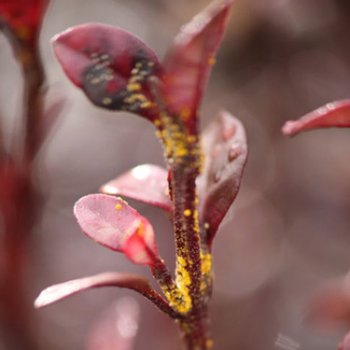
Eight new sites have been confirmed in Auckland, largely centred around the Eastern Suburbs. A third site has also been confirmed in Lower Hutt, close to the first two sites. As well as these, one new site was found in Bay of Plenty.
The indistry body says that the majority of finds are on private property (155 of 183 confirmed sites).
MPI have indicated that it will change the way that it responds to new finds of the disease and are considering moving from response, to a long-term management plan.
NZPPI & MPI have visited many nurseries and held industry meetings in the affected regions over the last few weeks, providing updates and answering questions. Further meetings are planned.
A well-established incidence of Myrtle Rust on Lophomyrtus (Ramarama) has been found in Lower Hutt. Read the MPI media release here.
A second location of myrtle rust infection has been found in Auckland – this time in the city, on ramarama plants at a private property in St Lukes. Read the media release from MPI here.
On 23 November, MPI issued a statement about the spread of myrtle rust into the West Auckland region. This development is a significant event for our industry as the disease is now in an area of the country with a large concentration of nurseries. Myrtle rust may begin to spread into other regions over time and businesses that grow or sell Myrtacea species need to now begin to prepare to respond to this crisis.
As the disease becomes established in more regions, MPI has indicated that it may change its approach to managing this disease. NZPPI will work closely with MPI to develop these management plans. It is possible that these may focus on a regional response and the use of plant protection practices within nurseries.
Following the announcement, all businesses that grow, distribute or sell any Myrtacea species should begin to plan for the scenario that the disease affects their businesses, either directly or indirectly at some time in the future.
What to do
- Be aware of the location of new infection sites, particularly within 10km of your nursery. NZPPI can provide information up to date about these sites;
- Continue to implement the myrtle rust management protocols and support your staff to follow the practices, even if you are not affected at the moment;
- Plan for your first response in the event that you find myrtle rust in, or near your nursery;
- Talk and share information with other nurseries and with your customers. It is important to build trust;
- Be prepared with accurate information for your customers and the public;
- Let NZPPI know what is happening and how it can help.
There is significant interest and concern about myrtle rust within the community. Plant producers and nurserymen have an important role to play in keeping the public informed with expertise and accurate information. Keep up to date via NZPPI’s newsletter updates and by checking the group’s website.
NZPPIs work
NZPPI says its team has worked tirelessly throughout this year to help businesses that have been affected by myrtle rust. This work has been widely acknowledged as it has benefited the nursery industry and the community. We are committed to continuing this work as the crisis develops. The spread of this disease may be out of our control, but there is still a lot that can be done to minimise its impact.
NZPPI says it needs everyone’s support and commitment to enable it to do this.
Source: NZPPI



 Classifieds
Classifieds

